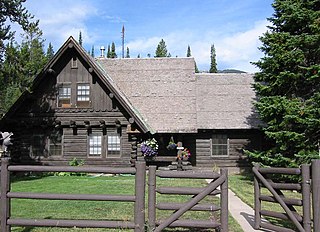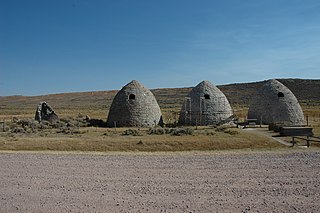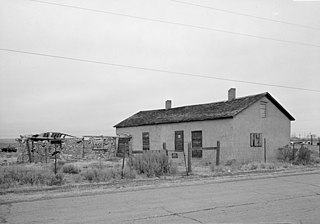
Wapiti Ranger Station is the oldest United States Forest Service ranger station in the United States. The station is located in Shoshone National Forest, Wyoming, and has been used continuously since it was built in 1903. The station was the first forest service ranger station built with federal funding. Constructed with native forest timber, the structure is maintained regularly, with some recent improvements – such as replacing some rotting timber – implemented in 2005.

The Old Administrative Area Historic District, also known as Beaver Creek, is the former headquarters area of Grand Teton National Park. The complex of five houses, three warehouses and an administrative building were designed in the National Park Service rustic style between 1934 and 1939 and were built by the Civilian Conservation Corps and the Public Works Administration. As part of the Mission 66 program, the park headquarters were relocated to Moose, Wyoming in the 1960s.

The AMK Ranch is a research center referred to as the University of Wyoming - National Park Research Station on the eastern shore of Jackson Lake in Grand Teton National Park. Also known as the Merymare, Lonetree and Mae-Lou Ranch, it was built beginning in the 1920s by William Louis Johnson, then expanded in the 1930s by Alfred Berol (Berolzheimer). Johnson built a lodge, barn and boathouse in 1927, while Berol added a larger lodge, new boathouse, and cabins, all in the rustic style.

The Jackson Lake Ranger Station is the last Depression-era U.S. Forest Service ranger station in its original location in Grand Teton National Park. When first established, the park comprised only the mountainous terrain above Jackson Hole, while the remainder of what would eventually become the park was administered by the Forest Service as part of Teton National Forest. The Jackson Lake Station was built in 1933 as close as possible to Park Service property as possible as a kind of resistance to the park's expansion. The station was one of five Forest Service stations in the area, and was taken over by the National Park Service when Jackson Hole National Monument was established in 1943, later becoming an enlarged Grand Teton National Park. It is the only such station not to have been moved or altered by the Park Service.

The White Grass Ranger Station includes several structures in the backcountry of Grand Teton National Park that were established to support horse patrols by park rangers. Built in 1930, White Grass is the only surviving horse patrol station in the park. The station, which includes a cabin, several sheds and a corral, was built to a standardized National Park Service plan, in the National Park Service rustic style.

The Squirrel Meadow Guard Station is a ranger station in the backcountry of Targhee National Forest in Wyoming. The original facility was established in 1907, with the present structures built in 1934. The log cabin station is an example of a standard US Forest Service backcountry patrol structure.

The Huckleberry Mountain Fire Overlook is a fire lookout station in northern Bridger-Teton National Forest. The rustic two-story log structure was built in 1938 by the Civilian Conservation Corps to a standard U.S. Forest Service design. The lookout was used for fire surveillance until 1957.

The String Lake Comfort Station is one of three similar buildings in Grand Teton National Park that were built by the Civilian Conservation Corps and the Public Works Administration to standard National Park Service plans. Built between 1934 and 1939, the String Lake station was originally located near the Jenny Lake ranger station. It is an example of the National Park Service Rustic style.
The Entrance Road at Devils Tower National Monument, officially known as Wyoming Highway 110, is a scenic road that provides the approach to the Devil's Tower eminence, affording planned views to arriving visitors.

The Rawhide Buttes Stage Station, the Running Water Stage Station and the Cheyenne-Black Hills Stage Route comprise a historic district that commemorates the stage coach route between Cheyenne, Wyoming and Deadwood, South Dakota. The route operated beginning in 1876, during the height of the Black Hills Gold Rush, and was replaced in 1887 by a railroad.

The Piedmont Charcoal Kilns in Piedmont, Wyoming, are a remnant of a once-extensive charcoal-making industry in southwestern Wyoming. The kilns were built by Moses Byrne around 1869 near the Piedmont Station along the Union Pacific Railroad. The three surviving beehive-shaped kilns were built of local sandstone about 30 feet (9.1 m) in circumference and about 30 feet (9.1 m) high, with 24-inch-thick (61 cm) walls. A granite marker reads:
Charcoal Kilns were built by Moses Byrne, 1869, to supply the pioneer smelters in the Utah Valley.

Wyoming Mercantile, also known as the Aladdin General Store is a preserved small-town general store in Aladdin, Wyoming. The store, which remains in operation, was built in 1896 by Amos Robinson as Wyoming Mercantile. Robinson died the same year, and the store went to Mahlon S. Kemmerer, who placed his properties, including the Wyoming and Missouri Valley Railroad, under the Wyoming Mercantile umbrella. Railroading continued until 1927. The store has continued, serving as a post office, bar, freight station and gas station.

Granger Station State Historic Site, also known as Granger Stage Station, South Bend Station and Ham's Fork Station, is a Wyoming state park dedicated to the interpretation of the station, the Pony Express and the Overland Trail. A settlement was first established about 1856 at the meeting of Ham's Fork with Black's Fork of the Green River, where a ferry crossed Ham's Fork. This became a station on the Pony Express in 1860-1861, then was a station on the Overland Trail in 1862. By this time it was known as the South Bend Station. In 1868 the trail was superseded when the Union Pacific Railroad arrived at the site. The station was deeded to the State of Wyoming in 1930. It is operated as a state historic site. The Granger Station was placed on the National Register of Historic Places on February 26, 1970.
Several sections of the Bozeman Trail in Wyoming are listed on the National Register of Historic Places. Typically there are sections of trail that are concentrated at geographic features such as fords or crossings of divides, where the trail consolidates from a broad swath of parallel, poorly defined paths to a small area where remnants of the trail are visible.
The Duck Lake Station Site is a former way station on the Overland Trail in Carbon County, Wyoming. Built in 1862, the site is located between the Dug Springs Station to the west and the Washakie Station to the east. Stations on the trail were typically about 15 miles (24 km) apart with the largest, most elaborate stations at 50-mile (80 km) intervals. The Duck Lake station was a more basic one-room building. All that remains of the station are its foundations. The site was placed on the National Register of Historic Places on December 6, 1978.
The Sage Creek Station Site is a former way station on the Overland Trail in Carbon County, Wyoming. Constructed about 1862, the station was built of logs with an adobe fireplace and a dirt roof over pole rafters. The site burned on June 8, 1865, but may have been rebuilt. All that remains of the station are its foundations. The site was placed on the National Register of Historic Places on December 6, 1978.
The Midway Station Site is a former way station on the Overland Trail in Carbon County, Wyoming. Built in 1850, the station was on a heavily traveled stage and emigration route, halfway between Saratoga and Walcott, providing its name. Nothing remains of the station beyond depressions in the earth. The site was placed on the National Register of Historic Places on December 6, 1978.
The Pine Grove Station Site is a former way station on the Overland Trail in Carbon County, Wyoming, near Bridger's Pass. It was built in 1862 by Robert Foote for $1500 and was described as a log building about 25 feet (7.6 m) by 60 feet (18 m) with an adjoining corral. The station was burned in 1865 and 1867 by Indians. Nothing remains of the station. The site was placed on the National Register of Historic Places on December 6, 1978.

The Washakie Station Site is a former way station on the Overland Trail in Carbon County, Wyoming. Built in 1862, the station was on a heavily traveled stage and emigration route. The station was a stone structure with a dirt roof over pole rafters.Remains of the station consist of foundations and ruined sandstone walls. The site was placed on the National Register of Historic Places on December 6, 1978.











